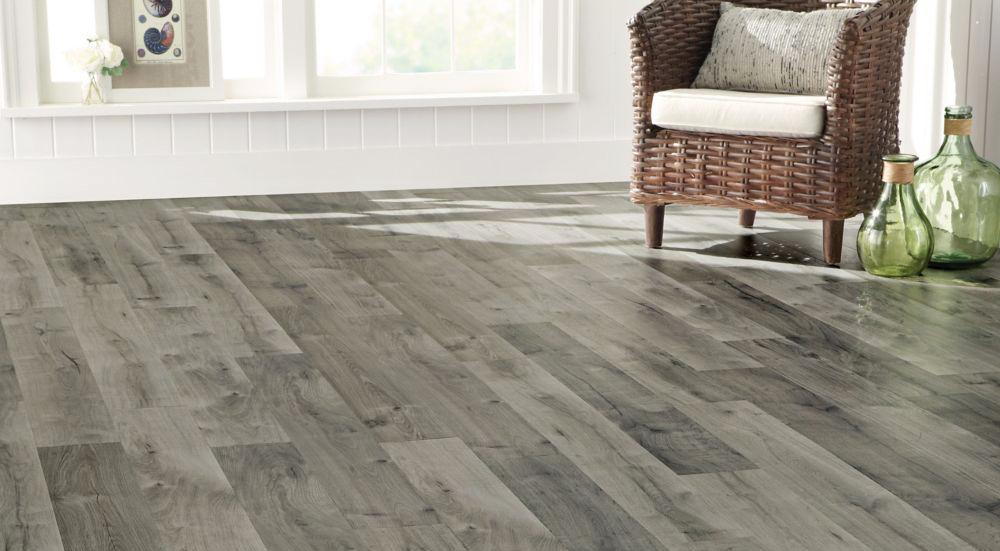A Look At The Pros And Cons Of Laminate Flooring

Want that gorgeous wood-look for a fraction of the price you’d spend on solid hardwood?
If your answer is yes, then laminate flooring is what you need to get.
A low-cost alternative to stone or standard wood flooring, laminate is a long-lasting floor that comes in a variety of attractive styles. Apart from being a popular flooring option in condos and rental homes, laminate is also ideal for businesses and family homes. The material’s realistic stone-and-wood-look and low-maintenance, low-cost cleaning make it a favorite for many.
Laminate flooring first debuted in the flooring market in the ‘70s as the first human-made, fully-synthetic alternative to natural wood. The flooring material quickly gained popularity as laminate manufacturers made increasingly realistic that easily passed for real wood.
The material was, in a sense, the pioneer of realistic, wood-looking flooring and paved the way for other flooring types. Since its inception, several different flooring materials have caught on and have started creating their wood looks. However, laminate remains to be the realistic wood-look flooring material of choice, and for various reasons too.
Laminate Flooring: Why Use It?
What keeps laminate flooring trending as one of the most popular flooring options in modern businesses and homes despite it being an old trend? To answer this question, here is a look at why current homeowners are still choosing laminate flooring:
The Benefits of Installing Laminate Flooring
More scratch resistant than vinyl: The material has a sturdy, hard-to-wear layer that protects the floor from dents, staining, scratches, and wear, all the things our furry friends do to our floors.
Durable: Laminate has supreme durability, which makes it an excellent option for homes with pets and kids and areas with high traffic.
Realistic wood and stone-looks: Laminate flooring planks tend to have surface detail, which further mimics the looks of natural hardwood. These planks can be made to have the feel and look of distressed hardwood, embossed wood, or hand-scraped hardwood and can come smooth or textured. Unlike real hardwood, the quality remains consistent across all laminate-based flooring boards.
It can be installed over a radiant heating system: This is one feature you will rarely find with a majority of hardwood flooring options.
It is water-resistant to some extent: Through research and development, the material is slowly improving its water-resistance. While it still isn’t waterproof as compared to vinyl flooring, a majority of today’s laminate floors can tolerate topical moisture. When properly installed, a laminate floor will keep water from seeping through its planks.

Easy to install: A laminate floor is designed to be fixed as a floating floor. This means that it’s not secured to the ground beneath it; instead, it ‘floats’ through a unique interlocking design. The installation process is relatively easy and can be done by anyone – which makes it a great DIY project. (Want to learn how to install a laminate floor? Check out the video below.)
Easy to maintain and clean: You can sweep or mop up messes as needed. With a laminate floor, floor waxing is not necessary.
Cost-Effective: A laminate floor is a more affordable alternative to a hardwood floor. Lower maintenance and even lower prices? Cheap laminate flooring.
Comfortable to stand on for extended periods: A majority of laminate installations have an underlayment that makes the floor a bit more comfortable to stand on.
Laminate Flooring Shortcomings
As much as we would love to continue talking about how laminate is the best flooring material, it still – like any other floor – has its shortcomings. As is the case with all types of flooring, there will always be some concerns to think about. Here are some of the less appealing aspects of laminate flooring:
Not recommended for basements or full bathrooms: Since these are two areas that are prone to flooding and leaks, you should consider installing a floor that is a bit more water-resistant. Fortunately, you can make a laminate floor more resistant to water by installing a vapor barrier and an underlayment or by installing it using the glue-down method.
It isn’t as water-resistant as vinyl floors: While the material’s capability to resist water has improved, it still can’t tolerate stagnant pools of water. Laminate’s water resistance, unlike vinyl’s, works from top to bottom instead of the other way around. If your subfloor is experiencing issues with moisture, consider installing a vapor barrier.
Sound: If poorly installed, a laminate floor can create an empty, hollow sound. Every product comes with comprehensive installation instructions, so installation shouldn’t be a problem. However, if you are worried that you won’t get it right, you can always have an expert do it for you. If you want your laminate floor quiet, consider installing a quality underlayment.
Comments are Disabled